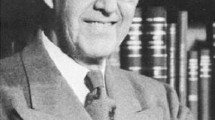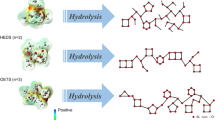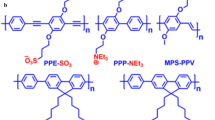Abstract
Like the chain transfer constant of carbon tetrachloride also the chain transfer constants of methylene bromide, bromoform, and bromotrichloromethane depend on monomer concentration in the polymerization of styrene. Whereas the chain transfer constant,\(\bar C\), of carbon tetrachloride decreases with decreasing monomer concentration, the reverse holds for methylene bromide and bromoform. Only for bromotrichloromethane a small increase of\(\bar C\) is observed with increasing styrene concentration. If it is again assumed that in presence of styrene the chain transfer agents named above exist in two forms of different reactivity-one free and one as a complex with monomer-contrary to what has been observed with carbon tetrachloride, the complexed forms of methylene bromide and bromoform must be the less reactive chain transfer agents compared to the free forms. Only in the case of bromotrichloromethane the complex has the higher reactivity in chain transfer. Further support for these views is gained from experiments carried out in presence of durene, which is a stronger complexing agent than styrene.
Zusammenfassung
Wie die Übertragungskonstante des CCl4 bei der Styrolpolymerisation, so zeigen auch die Übertragungskonstanten von CH2Br2, CHBr3 und CBrCl3 einen Gang bei Variation der Monomerkonzentration. Während aber beim Tetrachlorkohlenstoff eine Abnahme der Übertragungskonstanten\(\bar C\) mit fallender Monomerkonzentration auftritt, zeigt sich bei Methylenbromid und Bromoform der umgekehrte Effekt; lediglich bei Trichlorbrommethan nimmt\(\bar C\) mit steigender Styrolkonzentration etwas zu. Geht man wieder von der Annahme aus, daß die genannten Überträger bei der Styrolpolymerisation in zwei verschieden reaktiven Formen, einer freien und einer mit Styrol komplexierten, vorliegen, so bedeutet dies, daß nur bei CBrCl3 ebenso wie bei CCl4 der Komplex der stärkere Überträger ist, während bei CH2Br2 und CHBr3 die komplexierte Form die schwächere Übertragungswirkung besitzt. Diese Anschauungen werden auch durch Ergebnisse von Versuchen gestützt, die unter Zusatz von Durol, einem stärkeren Donator als Styrol, durchgeführt worden sind.
Similar content being viewed by others
Literatur
J. W. Breitenbach, A. Springer undE. Abrahamczik, Österr. Chemiker-Ztg.41, 182 (1938).
F. R. Mayo, J. Amer. Chem. Soc.65, 2324 (1943).
J. W. Breitenbach, O. F. Olaj, K. Kuchner undH. Horacek, Makromol. Chem.87, 295 (1965).
O. F. Olaj, Makromol. Chem.136, 255 (1970).
J. E. Clark undR. V. Luthy, Ind. Engng. Chem.47, 250 (1955).
J. R. Goates, R. J. Sullivan undJ. B. Ott, J. phys. Chem.63, 589 (1959).
J. B. Ott, J. R. Goates undA. H. Budge, J. phys. Chem.66, 1387 (1962).
F. Dörr undG. Buttgereit, Ber. Bunsenges. physik. Chem.67, 867 (1962).
R. Anderson undJ. M. Prausnitz, J. chem. Physics39, 1225 (1963).
R. F. Weimer undJ. M. Prausnitz, J. chem. Physics42, 3643 (1965).
M. L. McGlashan, D. Stubley undH. Watts, J. chem. Soc.A 1969, 673.
H. Kellawi undD. R. Rossinsky, J. chem. Soc.A 1969, 1207.
G. Meyerhoff, Z. physik. Chem. [N. F.]4, 335 (1955).
G. Henrici-Olivé undS. Olivé, Fortschr. Hochpolymeren-Forsch.2, 496ff. (1961).
J. W. Breitenbach, Makromol. Chem.8, 147 (1952).
O. F. Olaj, J. W. Breitenbach undN. Liaris, bisher noch unveröffentlichte Arbeiten.
Author information
Authors and Affiliations
Additional information
Herrn Prof. Dr.O. Kratky mit den herzlichsten Glückwünschen zum 70. Geburtstag gewidmet.
Mit 1 Abbildung
Rights and permissions
About this article
Cite this article
Breitenbach, J.W., Olaj, O.F. & Liaris, N. EDA-Komplexe als Kettenüberträger, 2. Mitt.. Monatshefte für Chemie 103, 990–999 (1972). https://doi.org/10.1007/BF00905171
Received:
Issue Date:
DOI: https://doi.org/10.1007/BF00905171




